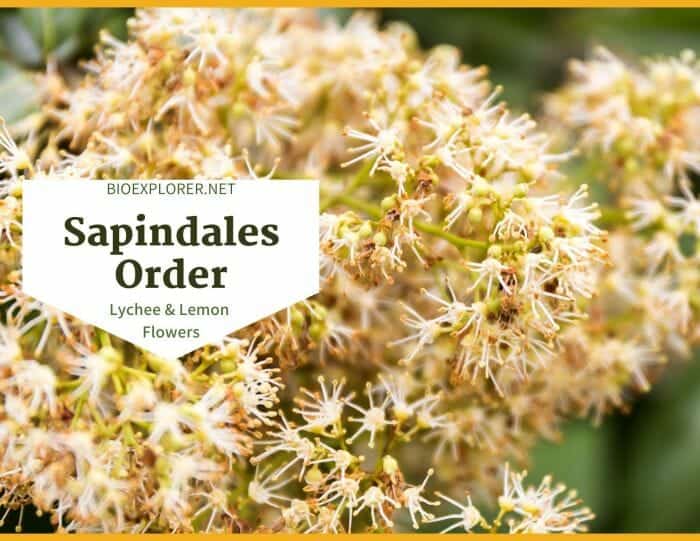
Order Sapindales belongs to the dicotyledonous flowering species under division Magnoliophyta, class Magnoliopsida, and subclass Rosidae. Many of the plants under order Sapindales are distributed in the tropics and the temperate regions.
Most plants of Sapindales are woody with resin ducts in their bark or wood, compound or lobed leaves, and polypetalous flowers. They are polygamous, with most bisexual flowers functionally unisexual. Among the critical species involve cashew, mahogany, Lemon, and lychee.
Table of Contents
Sapindales Families
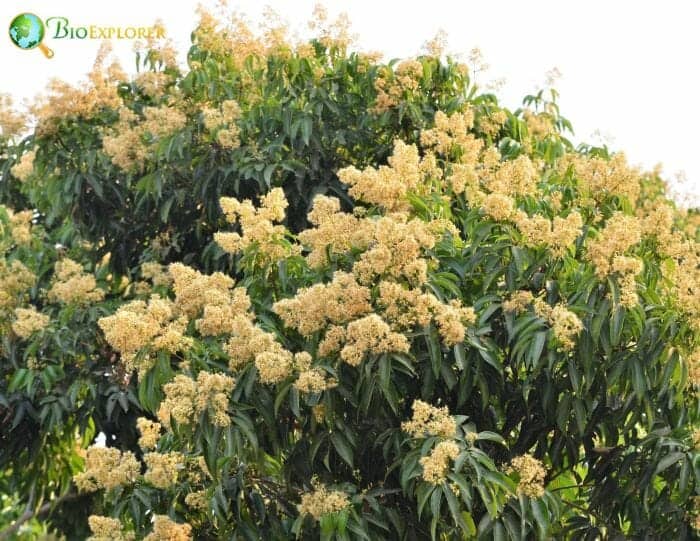
Sapindales comprises 9 families, 473 genera, and 6,567 species[1]. Families under Sapindales are:
- Anacardiaceae (Sumac family)
- Biebersteiniaceae
- Burseraceae (Frankincense family)
- Kirkiaceae
- Meliaceae (Mahogany family)
- Nitrariaceae
- Rutaceae (rue or citrus family).
- Sapindaceae (Soapberry family)
- Simaroubaceae (Quassia family)
![]()
Sapindales Distribution
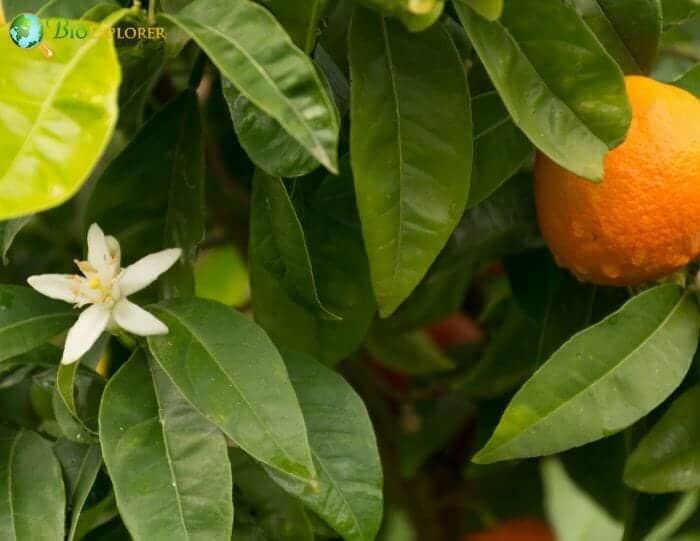
Many of the plants under order Sapindales are distributed in the tropics and the temperate regions.
- The members of the Sapindaceae (158 genera and 2230 species[2]) are mainly found in tropical areas. These species have abundant distribution in the American tropics. Anacardiaceae (60-74 genera and 400-600 species[3]) are distributed in tropical and subtropical regions. They have limited occurrence in temperate regions.
- The Biebersteiniaceae (1 genus and 5 accepted species[4]) are in temperate to sub-tropical regions. The species are present in Southeast Europe to Central Asia. The Burseraceae (16 plant genera and 615 accepted species[5]) are natives of tropical America. However, there are also a few species living in Africa and Asia.
- The Kirkiaceae (1 genus and 5 accepted species[6]) are found in Madagascar and the east coast of Africa. The Meliaceae (51 genera and 575 species[7]) has a pantropical distribution. Some species extend to temperate China, southeast Asia, and southeast Australia.
- The members of Nitrariaceae (3 genera and 12 species[8]) are thriving in dry and semi-dry regions of Southern Europe, Central Asia, and North Africa. Some Nitrariaceae members are also distributed in eastern Mexico and southern Australia.
- The Rutaceae (160 genera and 2070 species) are worldwide. They are primarily found in the tropical and temperate regions, with most distribution in Australia and Africa.
- The Simaroubaceae (32 genera and more than 170 species[9]) has a pantropical distribution. It is chiefly distributed in tropical areas of America and extends to Africa, Madagascar, and Australia regions.
![]()
Sapindales Characteristics
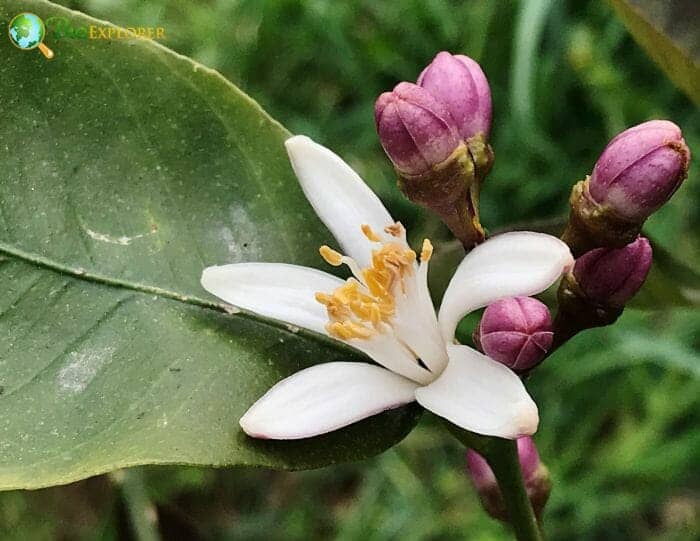
The following are the characteristics shared by the members of the Sapindales:
- Plant Type: Most Sapindales plants are woody. Members are generally large shrubs, trees, and woody climbers.
- Stems: A large proportion of the species possess resin ducts in their bark and wood.
- Leaves: The leaves are compound or lobed. Most species are pinnately compound. However, in rare cases, some species do have palmately compound leaves. The leaves of most species have glandular cavities. Generally, they have leaves with an alternate arrangement in a stem. The opposite or whorled arrangement is sporadic.
- Flowers and Inflorescences: Flowers are polypetalous. They may be single or arranged in racemes, cymose spikes, or panicles. The flowers are fragrant with colored petals. Their nectaries are well-developed. Flowers are either hypogynous or perigynous. Many species belonging to this order are polygamous. Consequently, they have bisexual and unisexual flowers on the same plant.
- Sepals and Petals: The sepals and petals are both 3-6. Some species lack petals. Both the sepals and petals are usually free. Some genera have fused petals and sepals.
- Stamens and Carpels: The stamens are distinct. The quantity is the same or twice the sepals. There are usually 3 carpels.
- Ovary and Fruits: Most have superior ovaries (few have inferior). The fruits are variable; samara, nut, capsule, schizocarp, drupe, or berry.
- Seeds: The number of seeds per fruit varies; arrilate or not. The seeds are non-endospermic (Anacardiaceae).
![]()
Sapindales Flowers and Reproduction
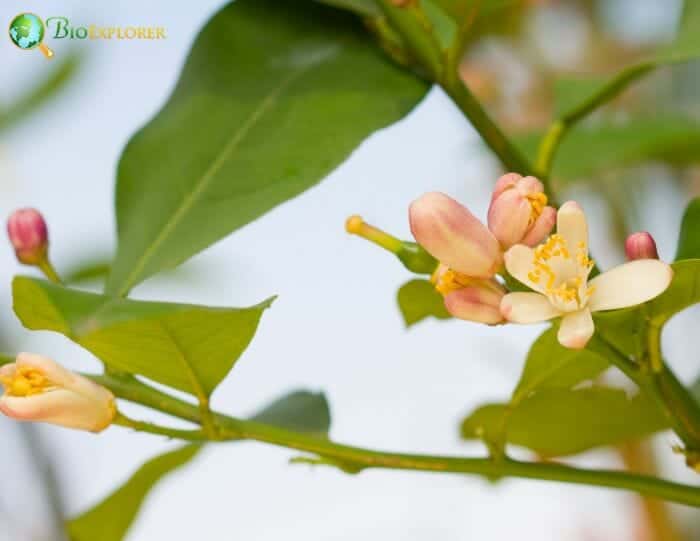
The flowers of the Sapindales’ members are bilaterally or radially symmetrical. Generally, they are small. In most cases, the sepals and petals exist. However, petals may be absent in some of the species. Both the sepals and petals are usually free. However, calyxWhat is calyx?A collective term for all the sepals of a flower; the lowermost whorl of floral orgrans (Plural form is calyces). consists of fused sepals in some genera, and the corollaWhat is corolla?A collective term referring to the petals of a flower. has fused petals.
- The flowers may exist singly or in inflorescences of racemes, cymose spikes, or panicles. These flowers are generally pollinated by insects. The colored petals and the fragrance of the flowers, and the abundance of the nectar serve as attractants to the insects.
- Many members of Sapindales are polygamous. This is a condition wherein bisexual and unisexual flowers occur in the same plant. This gives advantages to achieve variability increase through outcrossing and maximize fertility through inbreeding. However, many species with bisexual flowers are functionally unisexual. An example of this is the Maple.
- They are self-sterile. Thus, cross-pollination is a more effective reproduction for this condition.
- The soapberry or the Sapindaceae[10] is the most prominent family of this order. Their flowers are small and zygomorphicWhat is zygomorphic?A characteristic of the flower having only one plane of symmetry, as in a pea or snapdragon; bilaterally symmetrical; especially in reference to a flower or corolla; Opposite is Actinomorphic; irregular flower; or actinomorphicWhat is actinomorphic?A characteristic of the flower exhibiting radial symmetry such as starfish or Daisy flower; capable of being bisected into identical halves along more than one axis, forming mirror images. Opposite is Zygomorphic.. The species can be monoeciousWhat is monoecious?Pertaining to plants, individuals of which bear both staminate and pistillate flowers, but not necessarily perfect flowers. or dioeciousWhat is dioecious?Pertaining to plants, individuals of which bear either staminate or pistillate flowers, but not both.. However, although the flowers are structurally bisexual, they are functionally unisexual.
- Generally, they have biseriate perianth, comprising of corolla and calyx. There are 4 or 5 sepals and petals in the calyx and corolla. Some members lack the petals (Dodonaea). .
- They have distinct stamens. The stamens are usually hairy, and the quantity of the stamens may be the same or twice the calyx lobes number. Species usually have 3 carpels, generally with the same number of style or style lobes. The ovary is superior.
- The asymmetrical nectary disk is commonly found between the corolla and the stamens. Most pollination of the Sapindaceae is via birds and insects. Nonetheless, wind pollination occurs in a few species.
![]()
Sapindales Family Differences
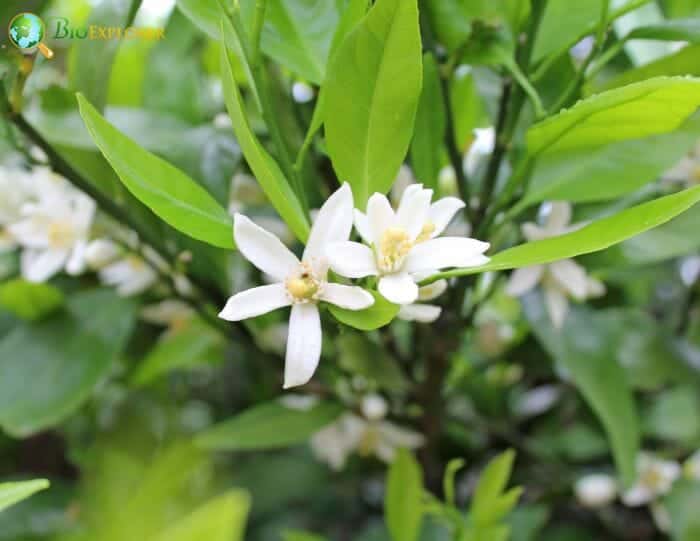
The families with the most species in this order are Sapindaceae, Rutaceae, Burseraceae, Anacardiaceae, and Meliaceae.
Sapindaceae
- The members are trees, lianas, shrubs, or herbaceous vines.
- The leaves of the species are mostly pinnately compound. Others are palmately compound, spirally alternate, opposite, or simply palmate. The base of the petiole is swollen. The members are exstipulateWhat is exstipulate?Without stipules; Stipule is a small structure of appendage found at the base of some leaf petioles..
- The flowers are small. They are unisexual and bisexual (functionally unisexual).
- The flowers are in cymes, thyrse, or raceme, sometimes umbel-like, rarely solitary.
- There are 4-5 sepals and petals.
- The ovary is superior.
- Nectaries are present.
- At maturity, the fruit may be fleshy or dry. The fruit is a variable. It can be samara, nut, berry, drupe, capsule, and schizocarp. The seeds are often arillate.
![]()
Rutaceae
- The species[11] under this order are trees, shrubs, and herbs.
- The leaves of the members are commonly opposite and compound. The species often have pellucid glands, giving the leaves their aromatic smell.
- Plants are exstipulate.
- The flowers do not possess bracts. They exist in cymes, solitary, or rarely in a raceme.
- Members are generally hermaphrodites.
- There are 3-5 sepals and petals. Some species lack petals.
- The ovary is superior.
- Nectaries are present.
- Fruit is a variable. The number of seeds per fruit also varies.
![]()
Burseraceae
- The members of this family are trees or shrubs. They possess essential oils in the bark. In addition, aromatic resin canals are found in the leaves, twigs, and bark of the trees and shrubs.
- The leaves of the members are alternate. They are mostly condensed at the tips of the branches. They are generally pinnate, possessing a terminal leaflet. This leaflet is pulvinusWhat is pulvinus?The enlarged base of a petiole or petiolule; functions in the movement of a leaf or leaflet; cushion-shaped; (E.g.: Plant pulvinus can be observed in Touch-me-not plant (mimosa pudica) where the leaf section has a thickening base) (thickening) at its base.
- The flowers are small and in a panicle. They are greenish.
- Both the sepals and petals are 3-5. The sepals are fused while the petals are free.
- The flowers are bisexual, or the male and female flowers usually exist on separate plants.
- The ovary is superior.
- The nectaries are present.
- The fruit is a drupe. The seeds are 1-5 per fruit, not arillate.
![]()
Anacardiaceae
- The members of this family[12] are trees or shrubs. They possess resinous or milky sap that may be very poisonous.
- The bark, phloem of petioles, and the leaves’ large veins possess vertical resin canals. They are also found in fruits and flowers.
- The leaves are almost always alternate. They are simple or pinnately compound. In very rare cases, the leaves are palmate or bipinnately compound. They are exstipulate.
- The flowers are unisexual or bisexual. The plants can be dioecious, monoecious, and andromonoeciousWhat is andromonoecious?A plant with staminate and perfect flowers, but missing pistillate flowers.. Other species are polygamous or hermaphroditeWhat is hermaphrodite?An organism or structure possessing both male and femal reproductive organs; a flower with both stamens and pistils. Other synonyms: bisexual or monoclinous..
- The flowers are rarely solitary. Their inflorescences can be terminal or axillary, paniculate, spicate, in thyrse, or racemose.
- There are 3-5 sepals and petals in the calyx and corolla.
- The ovary is mostly superior and rarely inferior.
- The fruits are often drupes. The seeds are non-endospermic.
![]()
Meliaceae
- Members of this family are trees and shrubs. A few species are herbaceous plants.
- The leaves are alternate. Mostly, the members have pinnate leaves having no stipules.
- The flowers are commonly in axillary thyrses. They are rarely in racemose or spicate.
- There are 3-6 lobed or distinct sepals in the calyx. The petals are 3-6, rarely more, in the corolla.
- Members are often dioecious. However, some species are monoecious. In some cases, a plant has female and bisexual flowers, and another has male and bisexual flowers (polygamodioecious).
- The ovary is superior.
- The fruit is a berry, a capsule, or a drupe.
![]()
Sapindales Example Species
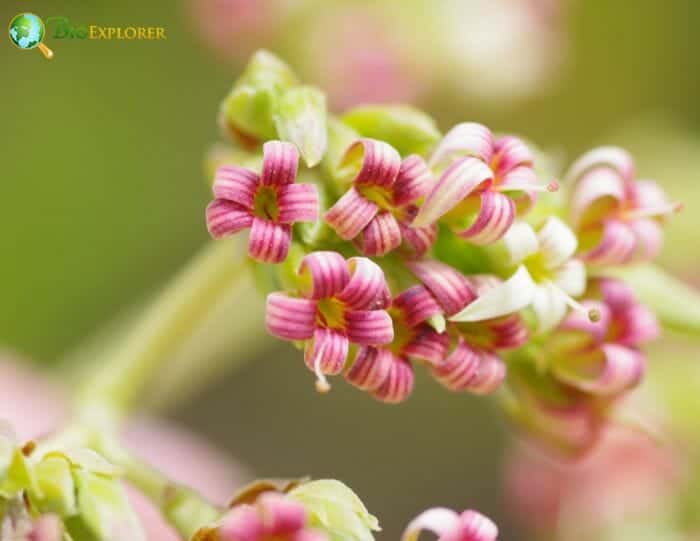
Plants under this order are very beneficial. The common plants under Sapindales include:
- Cashew – The nut is commonly eaten as food.
- Gaboon – The tree is used for the manufacture of plywood.
- Elephant tree is used for landscape, medicinal purposes, and wood for boxes.
- Mahogany is best as wood for furniture, cabinets, and construction.
- Neem tree – This tree has many medicinal benefits[13].
- Mandarin orange – The fruit is edible. The peel is consumed as a spice for cooking. It is also used as traditional medicine.
- Lemon – The fruit is edible. The oil is used in aromatherapy. The leaves are used for making teas.
- Lychee – The fruit is edible.
- Maple – The species are valued for their wood purposes.
- Wild rue or harmel – The plant is famous for folk medicine.
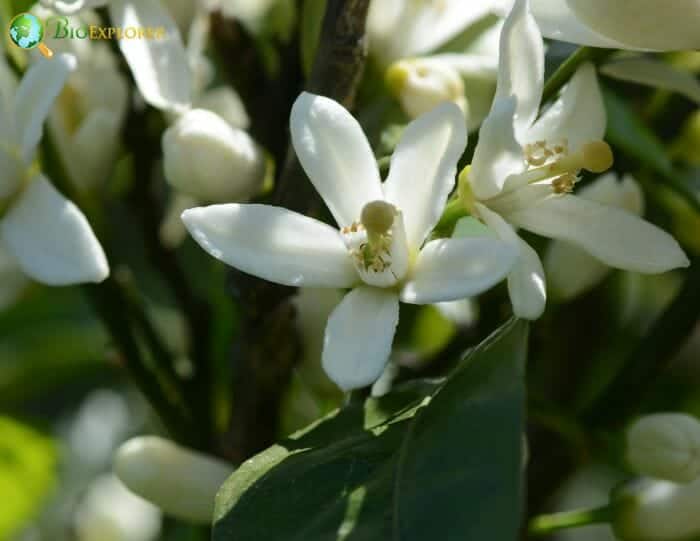
![]()











